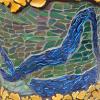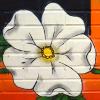Zane Cochran's 'Aurora' Lights Up the Lyndon House
Art Notes

"Aurora" by Zane Cochran
Primarily exclusive to the polar regions, an aurora is one of the most awe-inspiring events on Earth, created as a byproduct of complex disturbances in the magnetosphere and appearing as sublime curtains of vividly colored light across the night sky. Currently on view at the Lyndon House Arts Center through Friday, Oct. 13, Zane Cochran’s interactive installation “Aurora” offers a simulation of the planet’s naturally occurring light shows through the fusion of art and technology. Suspended lamps hang throughout the dark gallery in a variety of geometric forms and colors. Embedded with infrared sensors, each lamp gently wakes up as visitors approach and begins rippling through a unique sequence of lights, gradually fading out as the person walks away. The trail of glowing lanterns left behind in each walker’s path is not unlike the aurora’s bands of light across a sky.
Though the installation is sleek in appearance, a tremendous amount of data went into every minute detail. Fascinated by the Aurora Borealis and seeking to better understand and communicate how the natural phenomenon occurs, Cochran came across a 20-year database of scientific data collected by NASA’s Advanced Composition Explorer (ACE) satellite, as well as an Aurora Image Gallery that compiles spectacular light bands captured by arctic research stations, photographers and astronauts on the International Space Station.
“As I searched through that data, I found a beauty in the patterns of numbers that inspired me to create interactive lamps that merged the visual beauty of the Aurora Borealis and the computational beauty of the underlying physics of the phenomenon,” says Cochran.
Each of the installation’s 40 lamps represents a unique Aurora Borealis (northern lights) or Aurora Australis (southern lights) event. Using ACE’s data, Cochran developed a software program called PolyLamp through which the height, width, number of faces and overall geometry of each lamp was algorithmically programmed to reflect specific circumstances like the low- and high-energy electrons, solar wind and plasma levels that contributed to the event’s occurrence. The three-dimensional designs were then flattened onto paper, laser cut and folded into shape.
To mimic all of those otherworldly greens, pinks, blues and purples, Cochan created a separate piece of software called AuroraDatea that pulled prominent color patterns from the Aurora Image Gallery. Each lamp contains a custom circuit of a dozen programmable LEDs, each capable of over 16 million colors, that visualizes an aurora experience from a past time and place.
“I have always been interested in how art and technology can play off of each other to create a unique experience,” says Cochran. “I am finding that I can more accurately express my creativity by incorporating elements of technology in my artwork. It allows me to create an otherworldly experience through interactivity and lights that I wouldn't otherwise be able to achieve.”
Cochran is the founder of HackBerry Lab, an innovation space at Berry College dedicated to inventing, designing and building creative projects. What began as a simple place for him to tinker around with his ideas combining art, technology and prototyping has since grown to seven times its square footage and even larger in its scope of offerings. Access to 3D printers, woodworking and welding equipment and materials for programming electronics allows hundreds of students to materialize diverse projects such as an interactive, LED-embedded dress called PIXI and a 1970 Karmann Ghia converted into a fully electric car.
As a PhD student at Georgia Tech, Cochran is continuing his research into maker-oriented learning. His focus investigates how incorporating technologies and tools within traditional classroom curricula can enrich learning experiences. “Aurora” exemplifies the ability to educate an audience while visually and physically engaging them through a dazzling and interactive presentation.
“I hope that visitors can feel a sense of peace and wonder as they explore ‘Aurora’ in the same way that they might feel if they traveled hundreds of miles to see the real northern lights,” says Cochran. “Every aspect of the installation, from the lights to atmospheric music and open pathways through the lamps, was designed to allow visitors to make their own way through the space and spend a few moments away from the busy and noisy world to look up and enjoy an artwork inspired by a beautiful natural phenomenon.”
Cochran will offer a gallery talk sharing models and prototypes at the Lyndon House on Saturday, Oct. 7 at 2 p.m. Later that day from 7–10 p.m., Athens makerspace The Hatch will host a grand opening for its new facility, located in the Chase Park warehouses. Focused on STEAM education, the nonprofit will offer art and technology classes for both children and adults, as well as memberships with 24-hour access to 3D printers, a laser cutter, woodworking tools, an electronics lab and other resources.
Keywords
More by Jessica Smith
-

Art Around Town
A list of local art exhibits.
-

-

Art Around Town
A list of local art exhibits.









comments